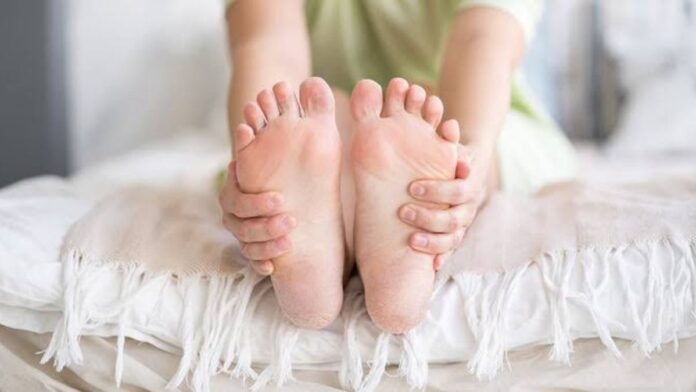Most cases of cracked heels can be effectively treated at home using moisturisers and products designed to soften or thin the skin.
New Delhi (India), March 5: Cracked heels develop due to dry and thickened skin around the edges of the heel. Typically, the main issue with cracked heels is their unsightly appearance. However, deep cracks can also cause discomfort, particularly when standing, and may occasionally lead to bleeding. In more severe cases, infection can occur if the cracks worsen. Fortunately, treating cracked heels can be straightforward. This article guides simple home remedies for managing this condition.
Tips to Heal Cracked Heels at Home
Here are some simple measures you can take to heal dry and cracked heels:
1. Use a Moisturising Cream or Heel Balm
The primary treatment for cracked heels involves using a moisturising cream or heel balm, such as Boroline Cream. These balms like boroline cream are formulated with ingredients that soften, moisturise, and remove dead skin. Some also contain components that aid in wound healing, assisting in the filling of cracks while alleviating any discomfort and irritation. Apply boroline cream in the morning to enhance skin elasticity before starting your day, and reapply two to three times throughout the day to maintain moisturised heels. It’s important to note that severe cases of cracked heels may necessitate a prescription-strength balm or steroid cream to reduce inflammation and relieve itching.
2. Wear Socks Made from Pure Cotton to Bed
Wearing 100% cotton socks to bed after the application of petroleum jelly on the heel may assist in retaining moisture and allowing the heel’s skin to breathe. It also helps in preventing the bed sheets from getting stained. After repeating this routine for a few days, you should notice the skin on the heels soften.
3. Soak and Exfoliate Your Heels
The skin surrounding cracked heels typically becomes thicker and drier compared to the rest of your skin, making it prone to splitting under pressure. Soaking and moisturising the feet can be beneficial. Here are some foot soak tips:
Submerge your feet in soapy, lukewarm water for around 20 minutes.
Use a foot scrubber, pumice stone, or loofah to gently remove any hardened, thickened skin.
Carefully pat your feet dry.
Once dried, apply a thick moisturiser or heel balm such as boroline cream to the affected area.
Make sure to avoid scrubbing your feet when they are dry as this can increase the risk of damaging the skin.
4. Apply a Liquid Bandage
Apply a liquid bandage to cracks as an alternative option. This helps seal the wound, preventing additional cracking or infections. Available in spray form, it allows you to continue your day without worrying about the bandage coming off. Liquid bandage is particularly useful for treating deep heel cracks that may bleed. Ensure the skin is clean and dry before applying the liquid bandage. As the cracks heal, the coating adheres to the skin’s surface. This product is readily available without a prescription at pharmacies.
5. Increase Your Water Intake
Boost your water intake when dealing with cracked heels. Instead of solely focusing on foot care, grab a water bottle, fill it up and start drinking. It’s crucial to ensure that you’re consuming an adequate amount of water. Your skin can lose approximately a litre of water daily, and even more in dry climates, so maintaining hydration levels is essential for preventing or soothing dry, cracked skin.
6. Use Coconut Oil
Utilise coconut oil, a commonly recommended remedy for dry skin, psoriasis and eczema. It aids in moisture retention for the skin. Applying coconut oil after a foot soak could prove beneficial as well. The antimicrobial and anti-inflammatory properties of coconut oil may assist in healing cracked heels, especially if they are prone to infections or bleeding.
7. Apply Honey
Use honey as a potential natural remedy for cracked heels. Honey is known to possess antibacterial and antimicrobial properties. It also aids in wound healing, moisturising and cleansing the skin. You can use honey as a foot scrub following a soak or apply it as an overnight foot mask.
Medical Treatments for Cracked Heels
For severe cases of cracked heels requiring medical attention, a doctor may:
Prescribe stronger skin removal or softening agents
Clinically remove dead skin
Prescribe antibiotics in case of an infection
Apply medical glue to seal cracks
Apply bandages or dressings to strap the heel
Assist patients in modifying their walking technique
Recommend shoe inserts, heel cups or heel pads
In most instances, cracked heels don’t typically pose a significant concern. You might find relief through over-the-counter or home remedies mentioned above. However, it’s advisable to consult a doctor if you experience severe cases of cracked heels or if you have underlying medical conditions such as diabetes.
If you have any objection to this press release content, kindly contact pr.error.rectification@gmail.com to notify us. We will respond and rectify the situation in the next 24 hours.
Views: 0



